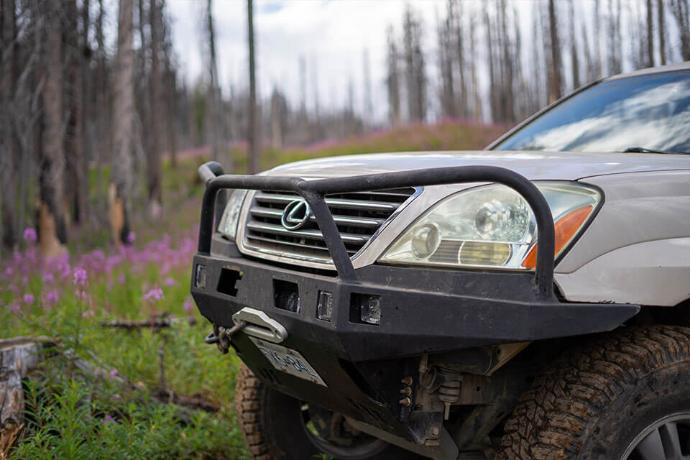No matter how built your vehicle is, there are situations where your tires simply run out of traction and you can find yourself stuck. Even with large, aggressive tires and front and rear differential lockers, an inconvenient tree stump or especially slippery hill climb can stop you in your tracks. In these situations, even just a light pull from a winch can make all the difference and allow you to overcome the obstacle with ease.
This is especially true if you like to explore by yourself, where there are no other vehicles to assist you with a tow strap or otherwise. A winch can make the difference between getting home safely and being stranded in the bush. Even in situations where there are other vehicles around to assist you, a pull from another vehicle with a tow strap involves a jerking motion and makes for a much less controlled recovery. This can lead to unwanted slipping of either vehicle and potentially even put both vehicles in a worse position than you started in! With a winch, the pulling motion is slow and controlled and this allows you to recover the vehicle in a much safer manner.
On narrow trails where passing is difficult, it may not be possible to get another vehicle into the right position to recover you with a tow strap anyways. With a winch, snatch block pulleys can be used to re-direct your winch line and get you out of nearly any situation. Just remember the main limitation of a winch: It does require a nearby anchor point to attach it to!
Luckily, offroad vehicle winches have been quite standardized across the manufacturers. While winches in the past have come in hydraulic, crankshaft-driven and even hand-crank versions, offroad winches today are fully electric and connect directly to your 12V battery. All winches in the 8-12,000lb capacity range use a standard 10x4.5" bolt pattern and are all very similar as far as length, height and width measurements go. This narrows down the decision to a few other factors explained below
With all that information in mind, how do you choose a winch for your truck? To make it easier for you to choose the right winch for your use, consider the following factors.
Start by thinking about how much your chosen winch needs to be able to handle. This largely depends on your truck weight. You will want to choose a winch with a capacity that is at least twice the total weight of your vehicle. For example, if your vehicle weighs 4000lbs, you will want a winch with a pull rating of at least 8000lbs. When calculating the weight of your vehicle, be sure to consider the additional gear and people that you will be likely to be carrying at the time as well. A weaker winch will stall out under load and if you are especially stuck, it may simply not have enough pulling strength to get you free.
A midsize truck such as a Tacoma or 4Runner will do best with a capacity of 9,000 to 10,000 pounds. For full-size 1/2 ton trucks, opt for 12,000lb or more. If you have a heavier diesel 3/4 or 1 ton with large offroading tires and accessories, consider a winch with a capacity of 16,500 or even 18,000 pounds
While a basic, entry-level winch will generally be sufficient for emergency situations, the more expensive winch models do offer some features that come in very handy if you are the type to be constantly pushing your vehicle and using the winch often.
A wireless remote is definitely our single favourite feature to have on a winch. With wired winches, you must physically plug your in/out control remote into the winch solenoid box, adding time to your recovery. If the vehicle is stuck in a precarious wheel stand or close to rolling over, it can be especially inconvenient to have to find your winch controller and plug it into the winch before beginning the recovery. A wireless remote allows you to conveniently and quickly control the winch from anywhere, wether it be from inside the vehicle, or from 80 feet up the trail such as when finding the right anchor point to winch off of. To take it one step further, some winches have remote clutches so you can even engage and disengage the winch clutch from the convenience and safety of your wireless remote.
Another noteworthy feature is waterproofing. Some winches have higher IP68 waterproof standard compliance, which means you can submerge the winch during water crossings and mud holes without worrying about damaging your winch.
The final feature to look out for is line speed. Higher end winches will generally have faster free spooling line speeds. This may not sound like a big deal, but spooling a slow winch in and out multiple times in a day does eventually get pretty old! Again, this feature may not be important if the winch is only being used for select emergency situations. However you will appreciate a faster line speed if you use your winch often.
Winches are available with either steel or synthetic lines. Steel is the traditional option. It is heavier than synthetic rope, but it is more resistant to abrasions and cheaper.
Synthetic winch lines are a bit newer, but have still been around for a long time now. Synthetic lines are lighter weight and much safer to use, but cost more and are more prone to damage from abrasions. How are synthetic lines safer? When a steel line breaks, the energy stored in the line will cause it to recoil like a whip and can seriously injure whoever is in its way. When a synthetic line breaks, it will simply fall to the ground and thus poses significantly less risk than steel. Synthetic ropes are also safer in that they will not develop sharp burs as they wear. Steel cables can fray and the resulting steel fibres are extremely sharp.
If your budget allows it, always choose a synthetic rope. If you are on a tight budget and only plan to use your winch for emergency recoveries, a steel rope will suffice but ensure you are aware of the safety precautions that come along with it.
Before you fit a winch on to your front bumper, don’t forget to consider the length of your winch rope. Most winches come with lines that are 80-100ft in length. While this sounds like more length than one could ever need, it runs out surprisingly quickly when there are not a lot of solid anchor points nearby. Due to the drum size of standard winches, it is generally not possible to add a longer rope to your winch. Instead, we recommend carrying additional recovery straps in your vehicle that you can then combine with your winch line when additional length is needed. Just be sure that the tow straps are rated sufficiently for your winch pull capacity.
Whether you are using a steel or synthetic line, never stand between the vehicle and its recovery anchor point during a recovery operation. I like to maintain the assumption that the winch line could fail at any time and behave accordingly. Even with a synthetic line that is less likely to slingshot when it breaks, other failures can still occur such as the winch hook or a shackle failing or slipping off under tension.
Possibly even more important is to speak up when you see others acting unsafely around winch recoveries. Especially when you have passengers in your group who may be experiencing offroading for their first time, they may be simply unaware of the potential dangers of winching. Politely remind them to maintain a generous distance from the winch line and if they can stand behind another vehicle or trail obstacle, that is even better. If you still don't believe me, go watch some winch accident videos and I promise you will gain a tremendous amount of respect for a winch line that is under 12,000lbs of tension!
As long as proper safety precautions are taken, a winch can be one of the most useful additions you can make to an offroad vehicle. A winch can be the difference between getting home safely and being stuck in the backcountry with no cell service or others around to help. It also feels great to use your winch to help others who are stuck. They'll be so grateful for your help and the next time you run into them, they will probably have made the decision to install a winch too!













